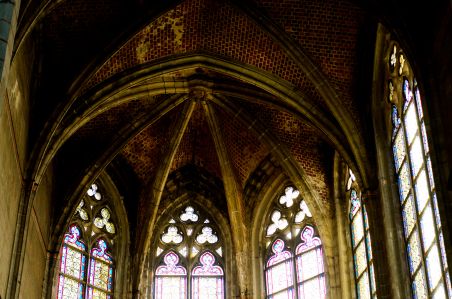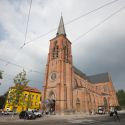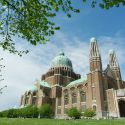Church | 1350-1490 | Gothic | Catholic Church


Explore your heritage
Free visit
31 May 2025 : 10.30 - 12.30 and 14.00 - 18.00Visit a unique Gothic Church in the Brabant Kouter and admire a single beautiful choir stalls.
Price
FreeContact
Michel Leunen+32 2 251 42 80
+32 478 42 48 25
micheletcatherineleunen@gmail.com
Organizers:
KerkfabriekMore about this church
Guided tour
Religious offices
Sunday 11 am
Description
The main church of Vilvoorde dates back to the fourteenth century. She replaced the preexisting Roman parish church. She was built with sandstone in a Gothic style. The construction of the choir and transept probably started in 1342 under the direction of architect Adam Gherijs. Due to lack of money, the nave could only be built in the fifteenth and sixteenth century.
Of the towers that were originally planned, only the north tower was completed. Until 1891 the building was enclosed by a churchyard. Around 1889 several layers of paint and plastering were removed within the church during restoration works.
The church possesses many sculptures: Melchisedek and Aaron on the main altar (17th century) were made by Frans Duguesnois. There are several polychrome wooden statues: Saint-Roch (17th century), St- Anthony of Padua (19th century), Our Lady of Sorrows (15th century), Christ lying in the grave (ca. 1630) and two statues of Our Lady with Child (16th century).
In addition there are also paintings to be admired: “The Four Evangelists” by Godefridus Maes (ca. 1700), “Lamentation of Christ” by Annibale Carracci (1560-1609) and a triptych signed by Jan Portaels (1852). The church also possesses several 18th century paintings imputed to the Flemish School.
The impressive baroque choir stalls with two rows of pews and representations of The Passion on both sides originally came from the priory of Groenendaal (Hoeilaart). They were bought in 1786. The baroque pulpit (1665) comes from the Saint-Joris church of Antwerp.
There are some remarkable tombstones to be found in the church, including that of Charles of Burgundy († 1535) and his spouse Catharina of Aalst († 1533): a bluestone bas-relief representing the deceased in a praying position. Furthermore there is the tombstone of Philip of Dongelberge (†1645). He was bailiff of Vilvoorde for a long time. His bluestone gravestone shows the deceased decomposing, adorned by escutcheons, and symbolizes the transitory nature of the grandeur and wealth of the Earth.
Source:
Inventaris voor het Bouwkundig Erfgoed (VIOE)
Photos
Remarkable elements
Choir stalls (17th century)
The sculpted choir stalls, that celebrated its 350 jubilee in 2013, originates from the Abbey of Groenendael. It’s a complex of theology, iconography, mythology, and classical literature with life-size sculptures and extraordinary detail. The depicted themes include the Passion of Christ, the apostles, the cardinal virtues, Saint Judy and the lamb, and the Adoration of the Magi. Scenes from the Greek mythology (Eneïs) are portrayed as well.
Pulpit (17th century)
Originally carved for the church of Saint George in Antwerp, the pulpit is by the hand of Artus Quellinus himself. Artus’s school experienced a full bloom in 1600-1700. The similarity with the choir stalls suggests that both come from the same school.
Tombstone of Charles of Burgundy and Catharina van Aelst (16th century)
The stunning tombstone from 1533 near the left exit was set up for the Knight Charles of Burgundy by his wife Catharina van Aelst. The presence of the page or jester at the bottom means that the knight was not killed on the battlefield, but died at home.
Tombstone for Knight Philip of Donghelberge
Knight Philip of Donghelberge was the meier, a type of bailiff for the Low Countries, of Vilvoorde for many years. He died in 1646. The text below is entirely marked by the image of the already decomposing body. “ Death portrayed myself here without beauty and equal to all alike. Whoever you are, you await no other destiny. I am whatever you are and what you are I was.”
Organ
The original organ for the church of Our Lady of Good Hope was built by Jean-Baptiste Goynaut in the year 1769. This instrument (with mechanical tracker) appears to be unchanged and remained intact until the beginning of the 20th century. The only mention of a thorough transformation of the organ is in 1902 by the organ builder Jos Stevens of Duffel. He dived the organ case, placed it on either side of the rood screen, expanded the disposition, and made the tracker pneumatic. One of the probable reasons for this change is that now the glass window of the rood screen is visible from the church. Space for the growing choirs, who took place on the rood screen, was also created this way.The mechanism was worn out after nearly a 100 years and the tracker was converted to an electrical connection between the keys and the wind chest. The latter has since been operated by electromagnets. The slow response of the pneumatic tracker is hereby a thing of the past and now the organ plays almost as good as any mechanical instrument. This was done in 1997 by organ builder Peter Vanhaecke from Erps-Kwerps.


















